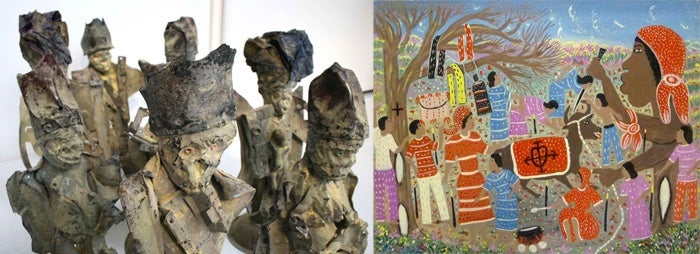Kafou: Haiti, Art and Vodou, Nottingham Contemporary, Nottingham

"The history of colonialism is that of a process of generalised zombification of mankind," wrote Haitian intellectual and poet René Depestre.
His text accompanies a painting called Zombis (c.1960) by Jacques-Enguerrand Gourgue, which shows a funeral procession of men with animal skulls for heads and haunting, hollowed-out eyes. They are bound to a coffin that threatens to burst open.
These zombies have not fallen under the diabolic spell of the Haitian houngan, or vodou (voodoo) priest. Instead, their docile, dead-in-life state is due to centuries of slavery, evoked by the imagery of binding.
Haiti declared its independence in 1804 and became the only nation born out of a successful slave revolt. For this, the people were punished. Vodou was demonised by the Western powers, who were terrified of similar revolts occurring elsewhere. Haiti itself – its dazzling, creative culture – was aligned with the dark side in a campaign of deliberate colonial propaganda.
This exhibition is exceptional for many reasons. To collect so many wonderful works in the aftermath of the 2010 earthquake is a feat. Moreover, these artists do not belong to the Haitian elite, trained in European art schools, but to the country’s majority – the urban and rural poor.
Often mislabelled “naïve” or “primitive” art, these paintings, sculptures, and sequinned flags are rooted in the vodou tradition, which is revealed to be a source of imagination and defiance, rather than evil. Here the will to be free is manifest in magic.
The figure of the artist occupies an esteemed position in Haitian culture – and it shows. Vodou Lwa (spirits) are re-invented according to fashion; they appear as flaneurs, pirates, and Disney-esque mermaids.
Paintings such as Ezili Freda (c.1950) by André Pierre are charged. As the spirit of love and beauty, Ezili is offered Virginia Slim cigarettes, sweet cakes, and pink champagne during rituals. Here she is robed in blue and casting a wry, sideways glance.
Pierrot Barra has transformed a cabbage-patch doll into a spirit adorned with beads, stones, and coins. Found-objects are combined in disturbing hybrids. The doll’s baby-blue eyes stare, unblinking; she seems unperturbed by her new function.
According to Depestre, zombification can be remedied by “a revitalising salt.” Like a supernatural kind of class consciousness, the salt will render man aware of his condition; he will become angry and murder his master. Spanning the last 70 years, these works are passionately in tune with Haiti’s revolutionary past.
Subscribe to Independent Premium to bookmark this article
Want to bookmark your favourite articles and stories to read or reference later? Start your Independent Premium subscription today.

Join our commenting forum
Join thought-provoking conversations, follow other Independent readers and see their replies